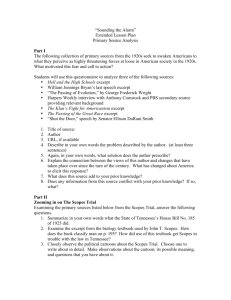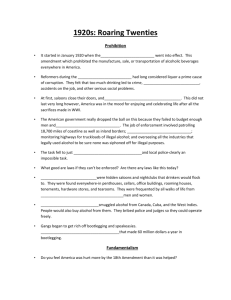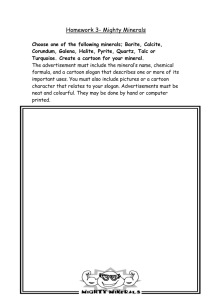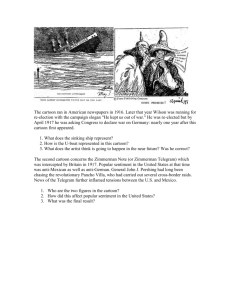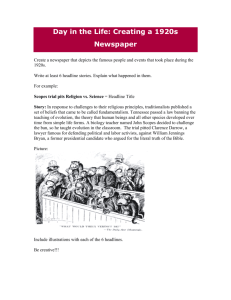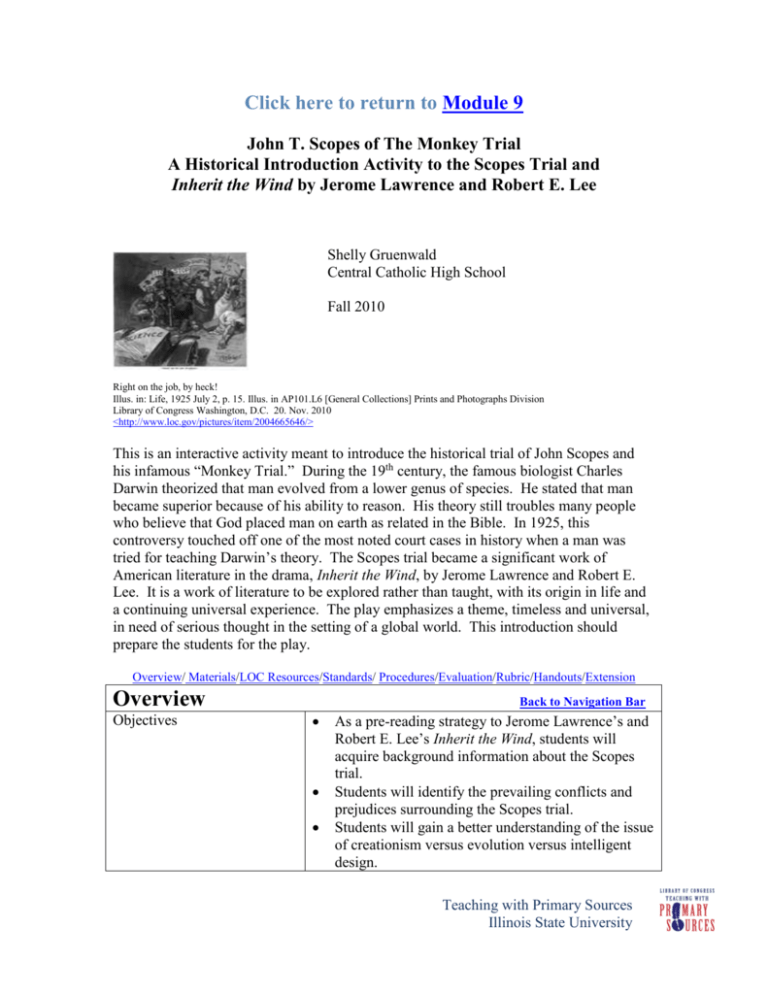
Click here to return to Module 9
John T. Scopes of The Monkey Trial
A Historical Introduction Activity to the Scopes Trial and
Inherit the Wind by Jerome Lawrence and Robert E. Lee
Shelly Gruenwald
Central Catholic High School
Fall 2010
Right on the job, by heck!
Illus. in: Life, 1925 July 2, p. 15. Illus. in AP101.L6 [General Collections] Prints and Photographs Division
Library of Congress Washington, D.C. 20. Nov. 2010
<http://www.loc.gov/pictures/item/2004665646/>
This is an interactive activity meant to introduce the historical trial of John Scopes and
his infamous “Monkey Trial.” During the 19th century, the famous biologist Charles
Darwin theorized that man evolved from a lower genus of species. He stated that man
became superior because of his ability to reason. His theory still troubles many people
who believe that God placed man on earth as related in the Bible. In 1925, this
controversy touched off one of the most noted court cases in history when a man was
tried for teaching Darwin’s theory. The Scopes trial became a significant work of
American literature in the drama, Inherit the Wind, by Jerome Lawrence and Robert E.
Lee. It is a work of literature to be explored rather than taught, with its origin in life and
a continuing universal experience. The play emphasizes a theme, timeless and universal,
in need of serious thought in the setting of a global world. This introduction should
prepare the students for the play.
Overview/ Materials/LOC Resources/Standards/ Procedures/Evaluation/Rubric/Handouts/Extension
Overview
Objectives
Back to Navigation Bar
As a pre-reading strategy to Jerome Lawrence’s and
Robert E. Lee’s Inherit the Wind, students will
acquire background information about the Scopes
trial.
Students will identify the prevailing conflicts and
prejudices surrounding the Scopes trial.
Students will gain a better understanding of the issue
of creationism versus evolution versus intelligent
design.
Teaching with Primary Sources
Illinois State University
Recommended time frame
Grade level
Curriculum fit
Materials
Students will consider recent issues and problems
concerned with determining what will be taught in
public schools.
3 days, 45-minute classes
9th
English, Biology, U.S. History, Theology, Government
PowerPoint lesson
The Butler Act
Danger: Indoctrination
Creationism: Monkeying With Science Education
Illinois State Common Core Standards
Back to Navigation Bar
Reading Standards for Literature 6-12:
Key Ideas and Details:
RL.9-10.1. Cite strong and thorough textual
evidence to support analysis of what the text says
explicitly as well as inferences drawn from the text.
RL.9-10.2. Determine a theme or central idea of a
text and analyze in detail its development over the
course of the text, including how it emerges and is
shaped and refined by specific details; provide an
objective summary of the text.
Integration of Knowledge and Ideas
RL.9-10.8. Delineate and evaluate the argument
and specific claims in a text, assessing whether the
reasoning is valid and the evidence is relevant and
sufficient; identify false statements and fallacious
reasoning.
Writing Standards 6-12:
Range of Writing:
RW.9-10.10. Write routinely over extended time
frames (time for research, reflection, and revision)
and shorter time frames (a single sitting or a day or
two) for a range of tasks, purposes, and audiences.
Procedures
Back to Navigation Bar
Day One:
Complete the first two columns of the KWL Chart.
The third column will be completed by the end of
the unit.
Discuss terms – Evolution, Creationism, and
Intelligent Design.
Read “The Butler Act” of 1925 and discuss.
Teaching with Primary Sources
Illinois State University
Open and begin PowerPoint presentation. Discuss
as necessary.
Assign students Hunter’s Civic Biology Handout as
Homework.
Day Two:
Finish Power Point Presentation and discuss as
necessary.
Go to “Summary of the Scopes Monkey Trial”
http://www.bradburyac.mistral.co.uk/tenness1.html
Assign Cartoon/Editorial project as homework. Due
in two days.
Day Three:
Read “Danger: Indoctrination A Scopes Trial for
the 90’s” and discuss as necessary.
Read “Creationism: Monkeying With Science
Education” and discuss as necessary.
Discuss current issues facing public schools today.
Collect KWL Charts.
Evaluation
Back to Navigation Bar
Extension
Students will create a project in which they will
create either a cartoon or write an editorial letter
depicting their opinion of evolution, Creationism, or
Intelligent Design.
Students will complete a KWL Chart.
Students will be tested over information learned and
retained on the unit test following the reading of
Inherit the Wind.
Click here for Rubric.
Back to Navigation Bar
Teaching with Primary Sources
Illinois State University
Primary Resources from the Library of Congress
Back to Navigation Bar
Image
Description
Caricature of policeman
"Tennessee" stopping auto
"Science" to allow mob of
armed religious fanatics under
flag of "bigotry" to pass.
Citation
Library of
Congress Prints
and Photographs
Division, General
Collections. Illus.
in: Life, 1925 July
2, p. 15.
Reproduction
number, LCUSZ62-67529.
URL
http://www.loc.gov/pictures/i
tem/2004665646/
“No more monkey business”
poster of Clarence Darrow
(left) and William Jennings
Bryan (right), attorneys in the
case of Tennessee vs. Scopes.
Library of
Congress, Yanker
Poster collection,
reproduction
number, LCUSZ62-128564.
Created/
Published:
American Civil
Liberties Union.
[1975].
Library of
Congress, Prints
and Photographs
Division. George
Grantham Bain
Collection.
Reproduction
number, LC-B26377-12.
http://www.loc.gov/pictures/i
tem/yan1996001208/PP/
Dayton, Tennessee,
Underwood &
Underwood/
CORBIS. Bettmann
Collection.
July 6, 1925,
Photographer:
George Rinhart.
http://www.corbisimages.co
m/Enlargement/BE043521.ht
ml
John T. Scopes.
The men responsible for
instigating the Scopes trial
(from left to right): George
W. Rappelyea, Professor
Walter White, Clay Green,
and R.E. Robinson.
http://www.loc.gov/pictures/i
tem/ggb2006013628/
Teaching with Primary Sources
Illinois State University
Inside a grandly decorated men's
club distinguished-looking,
elderly gentlemen interact with
monkeys. One sits on a mantle,
bonding with four monkeys. A
monkey smokes a cigar and
holds a newspaper with a bag of
peanuts at his feet. One monkey,
a waiter, brings a drink to a man
reading a newspaper. Paintings
of monkeys hang on the walls.
Library of
Congress, Cartoon
Drawings: Swann
Collection of
Caricature and
Cartoon. Creator:
Rea Irvin, March
18, 1915.
Reproduction
number, LCUSZ62-88147
http://www.loc.gov/pictures/i
tem/2009616892/
New Jury To Be Used on Scopes
Case
Original caption: 7/12/1925,
Dayton, TN. The new jury
selected to the Scopes case.
Front row: R.B. Smith, J.H.
Bowoman, J.H. Thompson, W.C.
Day, A.L. Centry, R.F. West,
Judge Raulston. Back row: J.G.
Wright, J.L. Goodrick, J.W.
Kiley, J.W. Dogley and W.F.
Robinson.
Five pages from Hunter’s Civic
Biology. The pages include the
following text, “The Races of
Man. -- At the present time there
exist upon the earth five races or
varieties of man, each very
different from the other in
instincts, social customs, and, to
an extent, in structure. These are
the Ethiopian or negro type,
originating in Africa; the Malay
or brown race, from the islands
of the Pacific; The American
Indian; the Mongolian or yellow
race, including the natives of
China, Japan, and the Eskimos;
and finally, the highest type of
all, the caucasians, represented
by the civilized white inhabitants
of Europe and America.
Dayton, Tennessee,
Underwood &
Underwood/
CORBIS. Bettmann
Collection.
July 12, 1925,
Photographer:
George Rinhart.
http://www.corbisimages.co
m/Enlargement/BE053672.ht
ml
Hunter’s Civic
Biology, pages 192 –
195, 1914.
Famous Trials
by Douglas O.
Linder (2010)
University of
Missouri – Kansas
City (UMKC)
School of Law.
Tennessee vs. John
Scopes. The
“Monkey” Trial,
1925.
http://www.law.umkc.edu/fa
culty/projects/ftrials/scopes/s
copes.htm
Teaching with Primary Sources
Illinois State University
Rubric
Back to Navigation Bar
Political Cartoon Rubric
Level 3 - Meets
Level 4 - Advanced expectations
Level 2 Meets partial
expectations
Political
content
Cartoon makes a great
connection to the past
eiter on the drawing or
the message that shows
comprehension of the
topic.
Cartoon makes some
connection to the past
either in the drawing or
the message that show
some comprehensions of
the topic.
Cartoon makes little
Cartoon makes no connection to the
connection to the past
past either in the drawing
either in the drawing or the
message and shows little
comprehension of the
topic.
Hidden
message
Student is able to include
4-5 visual cues in their
cartoon to support their
views.
Student is able to provide
3 visual cues in the
cartoon to support their
views.
Student is able to include 2 Student is able to include only one
visual cues in the cartoon visual cue in the cartoon to support
to support their views.
their views.
Creativeness
Student is able to create
an attractive and creative
visual of their cartoon
and its topic that is able
to be viewd by the class.
Student is able to create a
somewhat attractive and
creative visual of their
cartoon and its topic that
is able to be viewed by the
class.
Student is able to create a
visual of their cartoon and
its topic that is able to be
viewed by the class.
Student is able to create a visual of
their cartoon and its topic that is able
to be viewed by the class.
Phrasing
Student is able to portray
in their message a
creative/complete way of
identifying the views of
the student.
Student is able to
somewhat portray in their
message a
creative/complete way of
identifying his views.
Student is able to slightly
portray in their message a
creative/complete way of
identifying his views.
Student is not able to portray his
views.
Defend
Student can support their
messaging in the cartoon
and defend why they
created it
Student can somewhat
support their messaging in
the cartoon and defend
why they created it.
Student cannot support
their messaging in the
cartoon OR defend why
they created it.
Student cannot support their
messaging in the cartoon AND
defend why they created it.
CATEGORY
Level 1 Meets minimal
expectations
COMMENTS:
Teaching with Primary Sources
Illinois State University
Editorial Letter
Level 4 Advanced
Level 3 - Meets
expectations
Organization
(sequencing,
paragraphing,
development,
coherence)
Concise and engaging
introduction followed by
well-structured
paragraphs leading to a
persuasive conclusion.
Concise introduction followed General introduction followed
by logically organized
by loosely organized paragraphs
paragraphs that support an
leading to a weak conclusion.
effective conclusion.
An opening statement followed
by few relevant details. Weak
organization detracts from the
ideas being presented.
Ideas and
content
A strong position is
focused and wellsupported with pertinent
details and references
throughout. Detailed and
perceptive, overall.
A clear position is taken. Ideas
are logical and supported with
adequate details and
references. Detailed and
relevant, overall.
A position is attempted and/or is
vaguely defined. Ideas are
underdeveloped and are not
supported with adequate or
relevant details. Absence of
ideas and lack of understanding
found , overall.
Defend
Student can support
their messaging in the
letter and defend why
they wrote it
Student can somewhat support Student cannot support their
their messaging in the letter
messaging in the letter OR
and defend why they wrote it. defend why they wrote it.
Language
conventions
(grammar,
syntax, diction,
etc.)
The writing is well
crafted and proficient.
Errors are few and/or
minor.
The writing is effective.
Remaining errors do not
detract from the presentation
of ideas.
Overall impact
Engaging, insightful and Effective, thoughtful and
persuasive, overall.
persuasive, overall.
CATEGORY
Level 2 -Meets partial
expectations
A position is evident. Ideas and
details are offered but are not
fully developed or supported.
Limited and/or superficial in
ideas and content, overall.
Level 1 Meets minimal
expectations
Student cannot support their
messaging in the letter AND
defend why they wrote it.
The writing is competent.
The writing is simplistic.
Remaining errors do not detract Technical errors may impede
from the presentation of ideas. the communication of ideas.
Convincing and thoughtful at
times but requires elaboration
and further revision. Credible,
but ordinary.
Unclear and/or unconvincing,
overall. Tenuous and limited.
Further revision essential.
COMMENTS:
Teaching with Primary Sources
Illinois State University
Handouts
Back to Navigation Bar
Ms. Gruenwald
English 9
NAME______________
Paint Me a Picture in Words or Drawings!
Choose one of the following two assignments. Please put your name on the back. It will
be displayed in the room for the duration of the unit. You may need to reexamine the
trial facts to gather additional background information. The power point will be available
on the website. This project is worth 20 points.
Due on ______________.
1. Become a political cartoonist yourself. Create your own cartoon about the
evolution controversy. Your cartoon should include a drawing, a caption, and an
explanation of what you intend to convey. Write your descriptions based on your
knowledge of evolution and your understanding of the circumstances surrounding
this trial. Draw on a piece of blank computer paper.
2. Write an editorial letter for the newspaper explaining your thoughts on the
theories of evolution, Creationism, and Intelligent Design. Be sure to include
some facts and/or statistics to back up your opinion. This editorial must be typed.
Teaching with Primary Sources
Illinois State University
Ms. Gruenwald
English 9
NAME______________
KWL Chart
What I KNOW
Creationism
Evolution
Intelligent
Design
What I WANT to
know
What I LEARNED
CREATIONISM: Monkeying With Science Education
by Morris Sullivan art/Marty Kelley
IMPACT Press: Article: Dec. '99/Jan. '00 '99
http://www.impactpress.com/articles/decjan00/creatio.html
In the beginning God created the heavens and the earth.
In 1925, in a little town in Tennessee, a schoolteacher named John T. Scopes was prosecuted for teaching Darwin's
theory of evolution in a public school. The press called it the "Monkey Trial" because of the popular misconception
that Darwinism taught that man's ancestors were monkeys. Scopes was defended by Clarence Darrow, a nowlegendary criminal attorney.
Scopes lost the case; his sentence was a fine of $100. By the time the state supreme court overturned the conviction,
most of the world had been forced to take sides in a clash between religion and science. For some, the Biblical version
of creation was the only possible one; any admission that man might have come into existence by other means was
tantamount to questioning the very existence of God.
The Scopes trial serves as a great example of losing the battle but winning the war. While he lost initially and the law
stayed in the Tennessee statutes until the 1960s, most of America began to accept that the scientific method would
often reveal a glimpse of the workings of the universe that would contradict the Biblical explanations. Of course, this
wasn't the first time the world had seen that happen. It happened, too, when the Pope forced Galileo to recant his
teachings that the world was not, in fact, the center of the universe.
Now the earth was formless and empty, darkness was over the surface of the deep, and the Spirit of God was hovering
over the waters. And God said, "Let there be light," and there was light. God saw that the light was good, and he
separated the light from the darkness.
Now, due to the efforts of a handful of activists armed with a set of faulty "evidence," education about the source of
creation is in danger of being plunged back into darkness. For several years, "creationism," a movement made up of
religious-minded scientists and others has pushed state school boards to require public school science programs to
teach "alternative theories" about creation.
A little over a decade ago, the U.S. Supreme Court ruled that states cannot teach the belief that a divine power created
the universe. However, three states have begun to de-emphasize evolution in their curricula. The most dramatic
example is Kansas, whose school board has adopted new science testing standards. Caving in to pressure from
creationists, the state has revised the set of information that its students are expected to know and understand. No
longer will Kansas students be expected to understand the theory of evolution. Incidentally, they are no longer
expected to know anything about the big bang theory, either.
States generally derive their education standards from academic bodies that stay current on important information,
and look to these organizations for guidance when creating their testing standards. School Boards then look to the
testing standards for guidance when creating their curricula. Teachers are advised to tailor the contents of their course
planning to prepare their students to meet the testing standards. For all practical purposes, therefore, dropping a topic
from the testing standards removes it from the coursework.
The Kansas State Board of Education applied to the National Research Council, American Association for the
Advancement of Science and the National Science Teachers Association for permission to incorporate portions of
their published science standards into the Kansas Science Education Standards. After reviewing the Kansas standards,
the organizations denied that permission.
A joint statement released in September of 1999 by the three organizations says that "the Kansas standards effectively
eliminated consideration of any aspects of evolution that examine the origins of the Earth and life and processes that
may give rise to the formation of new species ... (and) adopted a position that is contrary to modern science ..."
Further, the statement points out a component of the creationist agenda--to show weaknesses in the hypotheses about
the extinction of dinosaurs--and identifies "at least an implicit attempt by the Kansas State Board of Education to
undermine a currently accepted body of knowledge. In fact, data gathered and analyzed by scientists from many
disciplines lend increasing weight to the prevailing ideas about how dinosaurs became extinct."
According to a separate statement released by the National Academy of Sciences, "... many scientific explanations
have been so thoroughly tested and confirmed that they are held with great confidence. The theory of evolution is one
of these well-established explanations. An enormous amount of scientific investigation since the mid-19th century has
converted early ideas about evolution proposed by Darwin and others into a strong and well-supported theory. Today,
evolution is an extremely active field of research, with an abundance of new discoveries that are continually
increasing our understanding of how evolution occurs."
And God said, "Let the land produce living creatures according to their kinds: livestock, creatures that move along the
ground, and wild animals, each according to its kind." And it was so.
The creationists only won a partial victory in Kansas--the de-emphasis of evolution. Their ultimate goal is that
"creationism" will be taught instead of, or at least alongside, the big bang and evolution. They argue that evolution is
only a "theory". As such, its no more scientific than the Biblical version of creation. Lots of people, who would like to
believe Genesis' version, agree. However, for most, their agreement is based on a misunderstanding of the term
"theory."
Many people use the term "theory" as a synonym for "opinion." However, in a science classroom, "theory" means
something very specific. A scientist formulates a hypothesis, which may explain a phenomenon. He or she then tests
the hypothesis through some means of experimentation or seeking supporting evidence. If the hypothesis passes the
test, then it is tested again and again by other scientists to see if it passes it consistently. If the testing supports the
hypothesis over and over, it becomes a theory. If it doesn't pass consistently, another hypothesis is sought. Sometimes,
a better hypothesis comes along that explains more or better. In that case, the old theory is discarded and the new
adopted.
A theory should not only explain what has happened, but predict what will happen. Theories about the Earth's
movement in the heavens, for example, accurately predict when the sun will rise. In science, a theory must be tested
using empirical means. In other words, at some point, the scientist must be able to perceive evidence for the theory
with normal human senses. Even then, the theory is not considered "fact" unless it becomes somehow empirically
observed. For instance, the theory that the earth is round can be "proved" either by travelling all the way around it or
by flying into space to look. Only then does it become fact.
In science, there are relatively few "facts."
Then God said, "Let us make man in our image, in our likeness, and let them rule over the fish of the sea and the birds
of the air, over the livestock, over all the earth, and over all the creatures that move along the ground."
Religion is another matter. Religion--or at least Christianity--insists that certain things be considered facts, based
purely on faith. In other words, you are supposed to believe, just because the religious view says to. The faithful will
tell you, for example, that God exists in fact, in spite of the total lack of empirical evidence for God's existence. If
pressed for evidence, they will come up with a series of irrational statements like, "Well, the world couldn't possibly
exist unless God made it," or "There has to be a reason for all this to exist." According to the religious world-view,
too, all of creation exists for the benefit of man.
In truth, of course, there are alternative explanations for the Earth's existence, lots of things happen for no reason, and
there's no evidence that the universe exists purely for our enjoyment. For the fundamentalist who wants to believe
every word of the Bible, however, life is a house of cards, with each card a tenet of faith. If you remove one card, the
entire house collapses.
So God created man in his own image, in the image of God he created him; male and female he created them.
The Christian fundamentalists want desperately to cling to their faith. In order to do that, however, they must
somehow reconcile science with the tenets of their faith. That's where Creationism comes in. Genesis says that the
world, including the first man and woman, was created in six days. If you add together all the "begats" in the Bible,
then you can determine its age at about 10,000 years, give or take a millenium. The goal of the creationists is to
"scientifically" support Genesis' version of the creation and to "scientifically" disprove both the Big Bang Theory and
Darwin's Theory of Evolution.
The creation scientists enjoyed a few victories in the early 1980's. For example, a 1981 Arkansas bill passed which
required the teaching of "creation science" in schools, including "evidences and inferences that indicate sudden
creation of the universe, energy, and life from nothing"; "the insufficiency of mutation and natural selection in
bringing about the development of all living kinds from a single organism"; "separate ancestry for man and apes"; and
"a relatively recent inception of the earth and living kinds." A similar law made it through the Louisiana legislature
that year.
Fortunately, the courts overturned those laws. The presiding judge in the Arkansas case, William Overton, called the
bill "a religious crusade, coupled with an attempt to conceal this fact" and that "both the purpose and effect is the
advancement of religion in the public schools."
However, that has not deterred the creationists. Unable to get their own "theory" into the curricula, they simply
changed strategy and began trying to get the competition eliminated. They attempt to accomplish this by using every
chance they can get to debate and "disprove" the scientific theories. Their methods employ manipulation of fact and
evidence; they also rely upon the relative ignorance of their non-scientist audiences and their listeners' strong desire to
"believe."
God blessed them and said to them, "Be fruitful and increase in number; fill the earth and subdue it. Rule over the fish
of the sea and the birds of the air and over every living creature that moves on the ground."
Evolution is a scientific theory; the Biblical story of creation is a myth. When you attempt to transform mythology
into science, you only succeed in reducing it to so much horse-shit.
Myths contain truths. Those truths, however, are not in the nature of scientific reasoning. Instead, those truths take the
form of allegory, of metaphor, of poetry. They bind us to one another and help us understand who we are. The
Biblical story of creation is a powerful myth. Reading the verses of Genesis helps us feel the connection to the
thousands of generations that came before us and our contact with greater mysteries than those sciences can resolve.
By trying to force fit those same verses to scientific reasoning, however, you defeat their purpose--you make them
ridiculous.
God saw all that he had made, and it was very good. And there was evening, and there was morning--and it was the
sixth day.
In the U.S., much of the power that legislates our day-to-day activities still lies in the hands of the states, not the
Federal government. That tradition has derived from the belief that, as William Jennings Bryan said in the 1920's, "the
essence of democracy is found in the right of the people to have what they want." Because of the varying "wants" of
populations scattered throughout the nation, it has long been assumed that state governments could best determine
what the people want.
However, we have another tradition in our country--that all Americans enjoy certain rights. The Bill of Rights was
added to the Constitution in order to protect the rights of the minority; the founding fathers recognized that the whim
of "the people" would at times conflict with the rights of the individual. Perhaps unfortunately, the founding fathers
did not include in their list the right to a good education.
One of the primary purposes of any society is the education of its children. The most primitive societies are structured
to provide its children with the knowledge and skills necessary to survive and succeed: to hunt and gather food, to
obtain shelter, to procreate and provide for their offspring. The education of the young also includes communicating
those values that will support the continued existence of the society.
One or two hundred years ago, the education received by students in Kansas probably had little effect on residents of
Florida, New York, and California. In fact, it was probably a good thing that much of education rested with the states,
whose economies and industries varied so greatly. Today, the "global village" has virtually become a reality, and it
has become imperative that our society ensure that all its children receive the best possible education.
"The best possible education" would include neither the deliberate teaching of horseshit nor the deliberate
withholding of information. As citizens of the global village, we should insist that all of our society's children learn
the best and most current information, and should never have information withheld because it conflicts with
someone's religious agenda.
The creationists are entitled to their rights to believe and express their opinions, no matter how cockamamie.
However, for a public school system within America to deliberately deprive its students of knowledge or teach them
shoddy science is almost criminal. All of us, whether parents or not, depend on the education of America's children to
create our future. We need to start demanding that education will build the future we want to inhabit, and to use the
courts and political systems as its architects.
Danger: Indoctrination
A Scopes Trial for the '90s
The Wall Street Journal, December 6, 1993
http://posh.roundearth.net/90's.htm
Stephen C. Meyer
When most of us think of the controversy over evolution in the public schools, we are likely to think of
fundamentalists pulling teachers from their classrooms and placing them in the dock. Images from the infamous
Scopes "monkey" trial of 1925 come to mind. Unfortunately, intolerance of this sort has shown itself in California in
the 1990s as a result of students complaining about a biology instructor. Unlike the original Scopes case, however,
thiscase involves a distinguished biology professor at a major university -- indeed, an acknowledged expert on
evolutionary theory. Also unlike Scopes, the teacher was forbidden to teach his course not because he taught
evolutionary theory (which he did) but because he offered a critical assessment of it.
The controversy first emerged last fall after Dean Kenyon, a biology professor at San Francisco State University, was
ordered not to teach "creationism" by John Hafernik, the chairman of his biology department. Mr. Kenyon, who
included three lectures in biological origins in his introductory course, had for many years made a practice of
exposing students to both evolutionary theory and evidence uncongenial to it. He also discussed the philosophical
controversies raised by the issue and his own view that living systems display evidence of intelligent design -- a view
not incompatible with some forms of evolutionary thinking.
Mr. Hafernik accused Mr. Kenyon of teaching what he characterized as biblical creationism and ordered him to stop.
After Mr. Hafernik's decree, Mr. Kenyon asked for clarification. He wrote the dean, Jim Kelley, asking what exactly
he could not discuss. Was he "forbidden to mention to students that there are important disputes among scientists
about whether or not chemical evolution could have taken place on the ancient earth?"
Mr. Kelley replied by insisting that Mr. Kenyon "teach the dominant scientific view," not the religious view of
"special creation on a young earth." Mr. Kenyon replied again (I paraphrase): I do teach the dominant view. But I also
discuss problems with the dominant view and that some biologists see evidence of intelligent design.
He received no reply. Instead, he was yanked from teaching introductory biology and reassigned to labs.
There are several disturbing aspects to this story:
First, Mr. Kenyon is an authority on chemical evolutionary theory and the scientific study of the origin of life. He has
a Ph.D. in biophysics from Stanford and is the co-author of a seminal theoretical work titled "Biochemical
Predestination" (1969). The
book articulated what was arguably the most plausible evolutionary account of how a living cell might have organized
itself from chemicals in the "primordial soup."
Mr. Kenyon's subsequent work resulted in numerous scientific publications on the origin-of-life problem. But by the
late 1970s, Mr. Kenyon began to question some of his own earlier ideas. Experiments (some performed by Mr.
Kenyon himself) increasingly contradicted the dominant view in his field. Laboratory work suggested that simple
chemicals do not arrange themselves into complex information-bearing molecules such as DNA -- without, that is,
"guidance" from human experimenters.
To Mr. Kenyon and others, such results raised important questions about how "naturalistic" the origin of life really
was. If undirected chemical processes cannot produce the coded strands of information found in even the simplest
cells, could perhaps a directing intelligence have played a role? By the 1980s, Mr. Kenyon had adopted the second
view.
That a man of Mr. Kenyon's stature should now be forced to lobby
for the right to teach introductory biology, whatever his current view of origins, is absurdly comic. Mr. Kenyon
knows perhaps as much as anyone in the world about a problem that has stymied an entire generation of research
scientists. Yet he now finds that he may not report the negative results of research or give students his candid
assessment of it.
What is more, the simplistic labeling of Mr. Kenyon's statements as "religion" and the strictly materialistic view as
"scientific" seems entirely unwarranted, especially given the philosophical overtones of much origins theory. Biology
texts routinely recapitulate Darwinian arguments against intelligent design. Yet if arguments against intelligent design
are philosophically neutral and strictly scientific, why are Mr. Kenyon's arguments for intelligent design inherently
unscientific and religiously charged? In seeking the best explanation for evidence, Mr. Kenyon has employed the
same method of reasoning as before he changed his view. His conclusions, not his methods, have changed.
The problem is that in biological origins theory, dominant players currently insist on a rigidly materialistic mode of
explanation -- even when, as Mr. Kenyon maintains, explanation of the evidence requires more than the limited
powers of brute matter. Such intellectual strictures reflect the very essence of political correctness: the suppression of
critical discourse by enforced rules of thought.
Fortunately, San Francisco State University's Academic Freedom Committee has come to a similar conclusion, ruling
decisively this summer in Mr. Kenyon's favor. The committee determined that, according to university guidelines, a
clear breach of academic freedom had occurred.
Apparently, however, Mr. Hafernik and Mr. Kelley disagree. Mr. Hafernik has emphatically rejected the committee's
recommendation to reinstate Mr. Kenyon, citing his own freedom to determine scientifically appropriate curriculum.
In response, the American Association of University Professors informed the university last month that they expect
Mr. Kenyon's mistreatment to be rectified. Meanwhile, as SFSU considers its response, a world-class scientist waits -yet another casualty of America's peculiar academic fundamentalism.
Copyright © 1993 Stephen C. Meyer. All rights reserved. International copyright secured.
File Date: 12.29.98
This data file may be reproduced in its entirety for non-commercial use.
Hunter’s Civic Biology, 1915, pages 192-195.
http://www.law.umkc.edu/faculty/projects/ftrials/scop
es/scopes.htm
The Butler Act
PUBLIC ACTS
OF THE
STATE OF TENNESSEE
PASSED BY THE
SIXTY - FOURTH GENERAL ASSEMBLY
1925
________
CHAPTER NO. 27
House Bill No. 185
(By Mr. Butler)
AN ACT prohibiting the teaching of the Evolution Theory in all the Universities, Normals and all other public schools of Tennessee, which are
supported in whole or in part by the public school funds of the State, and to provide penalties for the violations thereof.
Section 1. Be it enacted by the General Assembly of the State of Tennessee, That it shall be unlawful for any teacher in any of the Universities,
Normals and all other public schools of the State which are supported in whole or in part by the public school funds of the State, to teach any theory
that denies the story of the Divine Creation of man as taught in the Bible, and to teach instead that man has descended from a lower order of animals.
Section 2. Be it further enacted, That any teacher found guilty of the violation of this Act, Shall be guilty of a misdemeanor and upon conviction,
shall be fined not less than One Hundred $ (100.00) Dollars nor more than Five Hundred ($ 500.00) Dollars for each offense.
Section 3. Be it further enacted, That this Act take effect from and after its passage, the public welfare requiring it.
Passed March 13, 1925
W. F. Barry,
Speaker of the House of Representatives
L. D. Hill,
Speaker of the Senate
Approved March 21, 1925.
Austin Peay,
Governor.



